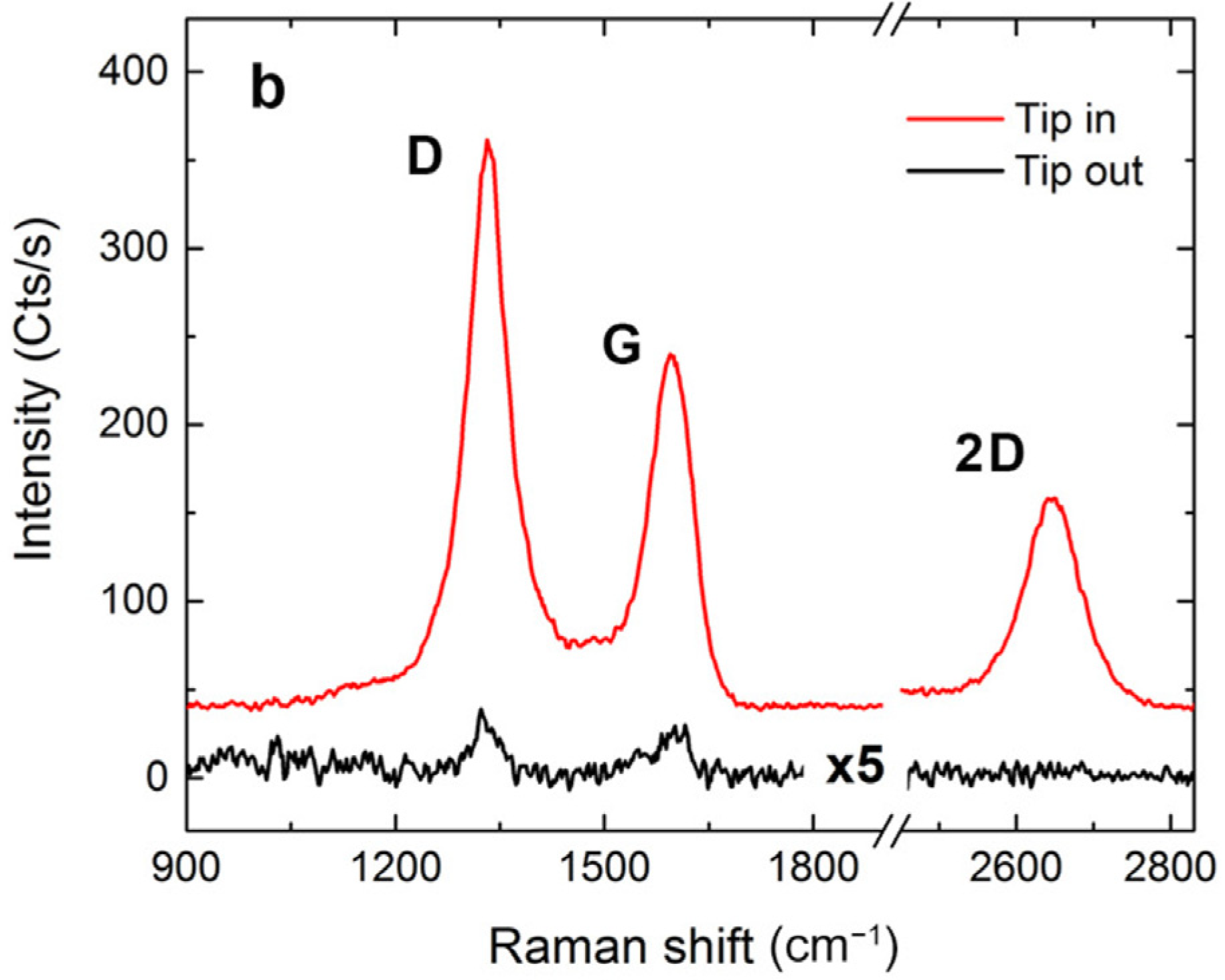Advances in Surface-Enhanced and Tip-Enhanced Raman Spectroscopy, Mapping and Methods Combined with Raman Spectroscopy for the Characterization of Perspective Carbon Nanomaterials
Data Availability Statement
Acknowledgments
Conflicts of Interest
References
- Kneipp, K.; Wang, Y.; Kneipp, H.; Perelman, L.T.; Itzkan, I.; Dasari, R.; Feld, M.S. Single molecule detection using surface-enhanced Raman scattering (SERS). Phys. Rev. Lett. 1997, 78, 1667–1670. [Google Scholar] [CrossRef]
- Weis, J.E.; Vejpravova, J.; Verhagen, T.; Melnikova, Z.; Costa, S.; Kalbac, M. Surface-enhanced Raman spectra on graphene. J. Raman Spectrosc. 2018, 49, 168–173. [Google Scholar] [CrossRef]
- Lai, H.S.; Xu, F.G.; Zhang, Y.; Wang, L. Recent progress on graphene-based substrates for surface-enhanced Raman scattering applications. J. Mater. Chem. B 2018, 6, 4008–4028. [Google Scholar] [CrossRef] [PubMed]
- Guo, Y.; Wang, H.; Ma, X.W.; Jin, J.; Ji, W.; Wang, X.; Song, W.; Zhao, B.; He, C.Y. Fabrication of Ag-Cu2O/Reduced Graphene Oxide Nanocomposites as Surface-Enhanced Raman Scattering Substrates for in Situ Monitoring of Peroxidase-Like Catalytic Reaction and Biosensing. Acs Appl. Mater. Interfaces 2017, 9, 19074–19081. [Google Scholar] [CrossRef] [PubMed]
- Qu, L.L.; Wang, N.; Xu, H.; Wang, W.P.; Liu, Y.; Kuo, L.D.; Yadav, T.P.; Wu, J.J.; Joyner, J.; Song, Y.H.; et al. Gold Nanoparticles and g-C3N4-Intercalated Graphene Oxide Membrane for Recyclable Surface Enhanced Raman Scattering. Adv. Funct. Mater. 2017, 27, 1701714. [Google Scholar] [CrossRef]
- Nguyen, T.H.D.; Zhang, Z.; Mustapha, A.; Li, H.; Lin, M.S. Use of Graphene and Gold Nanorods as Substrates for the Detection of Pesticides by Surface Enhanced Raman Spectroscopy. J. Agric. Food Chem. 2014, 62, 10445–10451. [Google Scholar] [CrossRef] [PubMed]
- Cabrera, F.C.; Aoki, P.H.B.; Aroca, R.F.; Constantino, C.J.L.; dos Santos, D.S.; Job, A.E. Portable smart films for ultrasensitive detection and chemical analysis using SERS and SERRS. J. Raman Spectrosc. 2012, 43, 474–477. [Google Scholar] [CrossRef]
- Zavatski, S.; Khinevich, N.; Girel, K.; Redko, S.; Kovalchuk, N.; Komissarov, I.; Lukashevich, V.; Semak, I.; Mamatkulov, K.; Vorobyeva, M.; et al. Surface Enhanced Raman Spectroscopy of Lactoferrin Adsorbed on Silvered Porous Silicon Covered with Graphene. Biosensors 2019, 9, 34. [Google Scholar] [CrossRef] [PubMed]
- Beams, R. Tip-enhanced Raman scattering of graphene. J. Raman Spectrosc. 2018, 49, 157–167. [Google Scholar] [CrossRef]
- Bhattarai, A.; Krayev, A.; Temiryazev, A.; Evplov, D.; Crampton, K.T.; Hess, W.P.; El-Khoury, P.Z. Tip-Enhanced Raman Scattering from Nanopatterned Graphene and Graphene Oxide. Nano Lett. 2018, 18, 4029–4033. [Google Scholar] [CrossRef] [PubMed]
- Foti, A.; Venkatesan, S.; Lebental, B.; Zucchi, G.; Ossikovski, R. Comparing Commercial Metal-Coated AFM Tips and Home-Made Bulk Gold Tips for Tip-Enhanced Raman Spectroscopy of Polymer Functionalized Multiwalled Carbon Nanotubes. Nanomaterials 2022, 12, 451. [Google Scholar] [CrossRef] [PubMed]
- Wu, J.B.; Lin, M.L.; Cong, X.; Liu, H.N.; Tan, P.H. Raman spectroscopy of graphene-based materials and its applications in related devices. Chem. Soc. Rev. 2018, 47, 1822–1873. [Google Scholar] [CrossRef] [PubMed]
- Lucchese, M.M.; Stavale, F.; Ferreira, E.H.M.; Vilani, C.; Moutinho, M.V.O.; Capaz, R.B.; Achete, C.A.; Jorio, A. Quantifying ion-induced defects and Raman relaxation length in graphene. Carbon 2010, 48, 1592–1597. [Google Scholar] [CrossRef]
- Ferreira, E.H.M.; Moutinho, M.V.O.; Stavale, F.; Lucchese, M.M.; Capaz, R.B.; Achete, C.A.; Jorio, A. Evolution of the Raman spectra from single-, few-, and many-layer graphene with increasing disorder. Phys. Rev. B 2010, 82, 125429. [Google Scholar] [CrossRef]
- Jorio, A.; Lucchese, M.M.; Stavale, F.; Ferreira, E.H.M.; Moutinho, M.V.O.; Capaz, R.B.; Achete, C.A. Raman study of ion-induced defects in N-layer graphene. J. Phys.-Condens. Matter 2010, 22, 334204. [Google Scholar] [CrossRef] [PubMed]
- Archanjo, B.S.; Barboza, A.P.M.; Neves, B.R.A.; Malard, L.M.; Ferreira, E.H.M.; Brant, J.C.; Alves, E.S.; Plentz, F.; Carozo, V.; Fragneaud, B.; et al. The use of a Ga+ focused ion beam to modify graphene for device applications. Nanotechnology 2012, 23, 255305. [Google Scholar] [CrossRef] [PubMed]
- Archanjo, B.S.; Maciel, I.O.; Ferreira, E.H.M.; Peripolli, S.B.; Damasceno, J.C.; Achete, C.A.; Jorio, A. Ion beam nanopatterning and micro-Raman spectroscopy analysis on HOPG for testing FIB performances. Ultramicroscopy 2011, 111, 1338–1342. [Google Scholar] [CrossRef] [PubMed]
- Pesce, P.B.C.; Araujo, P.T.; Nikolaev, P.; Doorn, S.K.; Hata, K.; Saito, R.; Dresselhaus, M.S.; Jorio, A. Calibrating the single-wall carbon nanotube resonance Raman intensity by high resolution transmission electron microscopy for a spectroscopy-based diameter distribution determination. Appl. Phys. Lett. 2010, 96, 051910. [Google Scholar] [CrossRef]
- Kharlamova, M.V.; Kramberger, C. Electrochemistry of Carbon Materials: Progress in Raman Spectroscopy, Optical Absorption Spectroscopy, and Applications. Nanomaterials 2023, 13, 640. [Google Scholar] [CrossRef] [PubMed]


Disclaimer/Publisher’s Note: The statements, opinions and data contained in all publications are solely those of the individual author(s) and contributor(s) and not of MDPI and/or the editor(s). MDPI and/or the editor(s) disclaim responsibility for any injury to people or property resulting from any ideas, methods, instructions or products referred to in the content. |
© 2023 by the author. Licensee MDPI, Basel, Switzerland. This article is an open access article distributed under the terms and conditions of the Creative Commons Attribution (CC BY) license (https://creativecommons.org/licenses/by/4.0/).
Share and Cite
Kharlamova, M.V. Advances in Surface-Enhanced and Tip-Enhanced Raman Spectroscopy, Mapping and Methods Combined with Raman Spectroscopy for the Characterization of Perspective Carbon Nanomaterials. Nanomaterials 2023, 13, 2495. https://doi.org/10.3390/nano13172495
Kharlamova MV. Advances in Surface-Enhanced and Tip-Enhanced Raman Spectroscopy, Mapping and Methods Combined with Raman Spectroscopy for the Characterization of Perspective Carbon Nanomaterials. Nanomaterials. 2023; 13(17):2495. https://doi.org/10.3390/nano13172495
Chicago/Turabian StyleKharlamova, Marianna V. 2023. "Advances in Surface-Enhanced and Tip-Enhanced Raman Spectroscopy, Mapping and Methods Combined with Raman Spectroscopy for the Characterization of Perspective Carbon Nanomaterials" Nanomaterials 13, no. 17: 2495. https://doi.org/10.3390/nano13172495
APA StyleKharlamova, M. V. (2023). Advances in Surface-Enhanced and Tip-Enhanced Raman Spectroscopy, Mapping and Methods Combined with Raman Spectroscopy for the Characterization of Perspective Carbon Nanomaterials. Nanomaterials, 13(17), 2495. https://doi.org/10.3390/nano13172495



